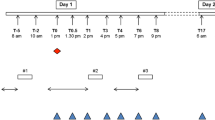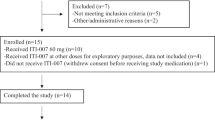Abstract
Rationale
A positron emission tomography (PET) study of dopamine D2 receptor occupancy was conducted to support a rational dose selection for clinical efficacy studies with lurasidone, an atypical antipsychotic that was approved for the treatment of schizophrenia by the FDA in late 2010.
Objectives
To determine the dopamine D2 receptor occupancy of lurasidone in the ventral striatum, putamen and caudate nucleus, and to characterize the relationship between lurasidone serum concentration and D2 receptor occupancy.
Methods
A single oral dose of lurasidone (10, 20, 40, 60, or 80 mg) was administered sequentially to healthy male subjects (n = 4 in each cohort). Two PET scans were performed. For each scan, 20 mCi of [11C]raclopride was administered intravenously as a bolus injection, followed immediately by 90 min of PET scan acquisitions.
Results
The D2 receptor occupancy levels were 41–43 % for 10 mg, 51–55 % for 20 mg, 63–67 % for 40 mg, 77–84 % for 60 mg, and 73–79 % for 80 mg of lurasidone. The relationship between D2 receptor occupancy and the mean serum lurasidone concentration during the PET scan (C PET) was similar for the putamen, caudate nucleus, and ventral striatum regions. Mean D2 receptor occupancy levels correlated well with average peak serum concentration of lurasidone.
Conclusions
In healthy volunteers, single doses of lurasidone 40–80 mg resulted in D2 receptor occupancy levels of >60 %, a level of receptor occupancy previously associated with clinical response for atypical antipsychotics.


Similar content being viewed by others
References
Abanades S, van der Aart J, Barletta JA, Marzano C, Searle GE, Salinas CA, Ahmad JJ, Reiley RR, Pampols-Maso S, Zamuner S, Cunningham VJ, Rabiner EA, Laruelle MA, Gunn RN (2011) Prediction of repeat-dose occupancy from single-dose data: characterization of the relationship between plasma pharmacokinetics and brain target occupancy. J Cereb Blood Flow Metab 31:944–952
Ashburner, J, Friston, KJ (2003) Rigid body registration. In Frackowiak, RSJ, Friston, KJ, Frith, C, Dolan, R (eds) Human brain function, 2nd edition. Academic Press, pp 635–654
Baumann B, Danos P, Krell D, Diekmann S, Leschinger A, Stauch R, Wurthmann C, Bernstein HG, Bogerts B (1999) Reduced volume of limbic system-affiliated basal ganglia in mood disorders: preliminary data from a postmortem study. J Neuropsychiatry Clin Neurosci 11:71–78
Citrome L (2011) Lurasidone for schizophrenia: a review of the efficacy and safety profile for this newly approved second-generation antipsychotic. Int J Clin Pract 65:189–210
DeGrado TR, Turkington TG, Williams JJ, Stearns CW, Hoffman JM, Coleman RE (1994) Performance characteristics of a whole-body PET scanner. J Nuc Med 35:1398–1406
Ehret MJ, Sopko M, Lemieux T (2010) Focus on lurasidone: a new atypical antipsychotic for the treatment of schizophrenia. Formulary 45:313–317
Ehrin E, Farde L, Paulis T, Eriksson L, Greitz T, Johnström P, Litton JE, Nilsson JL, Sedval G, Stone-Elander S (1985) Preparation of 11C-labelled Raclopride, a new potent dopamine receptor antagonist: preliminary PET studies of cerebral dopamine receptors in the monkey. Int J Appl Radiat Isot 36:269–273
Farde L, Nyberg S, Oxenstierna G, Nakashima Y, Halldin C, Ericsson B (1995) Positron emission tomography studies on D2 and 5-HT2 receptor binding in risperidone-treated schizophrenic patients. J Clin Psychopharmacol 15(Suppl 1):19S–23S
Gründer G, Landvogt C, Vernaleken I, Buchholz HG, Ondracek J, Siessmeier T, Härtter S, Schreckenberger M, Stoeter P, Hiemke C, Rösch F, Wong DF, Bartenstein P (2006) The striatal and extrastriatal D2/D3 receptor-binding profile of clozapine in patients with schizophrenia. Neuropsychopharmacol 31:1027–1035
Ichise M, Toyama H, Innis RB, Carson RE (2002) Strategies to improve neuroreceptor parameter estimation by linear regression analysis. J Cereb Blood Flow Metab 22:1271–1281
Innis RB, Cunningham VJ, Delforge J, Fujita M, Gjedde A, Gunn RN (2007) Consensus nomenclature for in vivo imaging of reversibly binding radioligands. J Cereb Blood Flow Metab 27:1533–1539
Ishibashi T, Horisawa T, Tokuda K, Ishiyama T, Ogasa M, Tagashira R, Matsumoto K, Nishikawa H, Ueda Y, Toma S, Oki H, Tanno N, Saji I, Ito A, Ohno Y, Nakamura M (2010) Pharmacological profile of lurasidone, a novel antipsychotic agent with potent 5-hydroxytryptamine 7 (5-HT7) and 5-HT1A receptor activity. J Pharmacol Exp Ther 334:171–181
Kapur S, Zipursky RB, Remington G (1999) Clinical and theoretical implications of 5-HT2 and D2 receptor occupancy of clozapine, risperidone, and olanzapine in schizophrenia. Am J Psychiatry 156:286–293
Kapur S, Zipursky R, Jones C, Remington G, Houle S (2000) Relationship between dopamine D(2) occupancy, clinical response, and side effects: a double-blind PET study of first-episode schizophrenia. Am J Psychiatry 157:514–520
Kim E, Howes OD, Kim B-H, Yu KS, Jeong JM, Lee JS, Kim SJ, Jang IJ, Park JS, Kim YG, Shin SG, Turkheimer FE, Kapur S, Kwon JS (2011) The use of healthy volunteers instead of patients to inform drug dosing studies: a [11C]raclopride PET study. Psychopharmacology (Berl) 217:515–523
Latuda Prescribing Information (2012) Accessed on the web on May 31, 2012 at: http://www.latuda.com/LatudaPrescribingInformation.pdf
Loebel A, Cucchiaro J, Sarma K, Xu L, Hsu C, Kalali Ah, Pikalov A, Potkin SG (2013a) Efficacy and safety of lurasidone 80 mg/day and 160 mg/day in the treatment of schizoprenia: a ramdomized, double-blind, placedo- and active-controlled trial. Schizophr Res 145:101–109
Loebel A, Cucchiaro J, Xu J, Sarma K, Pikalov A, Kane JM (2013b) Effectiveness of lurasidone vs. quetiapine XR for relapse prevention in schizophrenia: A 12-month, double-blind, noninferiority study. Schizophr Res. doi:10.1016/j.schres.2013.03.013
Maes F, Collignon A, Vandermeulen D, Marchal G, Suetens P (1997) Multimodality image registration by maximization of mutual information. IEEE Trans Med Imaging 16:187–198
Mamo D, Kapur S, Shammi CM, Papatheodorou G, Mann S, Therrien F, Remington G (2004) A PET study of dopamine D2 and serotonin 5-HT2 receptor occupancy in patients with schizophrenia treated with therapeutic doses of ziprasidone. Am J Psychiatry 161:818–825
Mamo DC, Uchida H, Vitcu I, Barsoum P, Gendron A, Goldstein J, Kapur S (2008) Quetiapine extended-release versus immediate-release formulation: a positron emission tomography study. J Clin Psychiatry 69:81–86
Meltzer HY, Cucchiaro J, Silva RS, Ogasa M, Philips D, Xu J, Kalali AH, Schweizer E, Pikalov A, Loebel A (2011) Lurasidone in the treatment of schizophrenia: a randomized, double-blind, placebo- and olanzapine-controlled study. Am J Psychiatry 168:957–967
Meyer JM, Loebel AD, Schweizer E (2009) Lurasidone: a new drug in development for schizophrenia. Expert Opin Investig Drugs 18:1715–1726
Moons T, de Roo M, Claes S, Dom G (2011) Relationship between P-glycoprotein and second-generation antipsychotics. Pharmacogenomics 12:1193–1211
Nakamura M, Ogasa M, Guarino J, Phillips D, Severs J, Cucchiaro J, Loebel A (2009) Lurasidone in the treatment of acute schizophrenia: a double-blind, placebo-controlled trial. J Clin Psychiatry 70:829–836
Oswald LM, Wong DF, McCaul M, Zhou Y, Kuwabara H, Choi L, Brasic J, Wand GS (2005) Relationships among ventral striatal dopamine release, cortisol secretion, and subjective responses to amphetamine. Neuropsychopharmacol 30:821–832
Sakurai, H, Bies, RR, Stroup, ST, Keefe RS, Rajji TK, Suzuki T, Mamo DC, Pollock BG, Watanabe K, Mimura M, Uchida H, 2012. Dopamine D2 receptor occupancy and cognition in schizophrenia: analysis of the CATIE data. Schizophr Bull [Epub ahead of print]
Shimada T, Yamazaki H, Mimura M, Inui Y, Guengerich FP (1994) Interindividual variations in human liver cytochrome P-450 enzymes involved in the oxidation of drugs, carcinogens and toxic chemicals: studies with liver microsomes of 30 Japanese and 30 Caucasians. J Pharmacol Exp Ther 270:414–423
Uchida H, Takeuchi H, Graff-Guerrero A, Suzuki T, Watanabe K, Mamo DC (2011a) Dopamine D2 receptor occupancy and clinical effects: a systematic review and pooled analysis. J Clin Psychopharmacol 31:497–502
Uchida H, Takeuchi H, Graff-Guerrero A, Suzuki T, Watanabe K, Mamo DC (2011b) Predicting dopamine D2 receptor occupancy from plasma levels of antipsychotic drugs: a systematic review and pooled analysis. J Clin Psychopharmacol 31:318–325
Vernaleken I, Fellows C, Janouschek H, Bröcheler A, Veselinovic T, Landvogt C, Boy C, Buchholz HG, Spreckelmeyer K, Bartenstein P, Cumming P, Hiemke C, Rösch F, Schäfer W, Wong DF, Gründer G (2008) Striatal and extrastriatal D2/D3-receptor-binding properties of ziprasidone: a positron emission tomography study with [18 F]Fallypride and [11C]Raclopride (D2/D3-receptor occupancy of ziprasidone). J Clin Psychopharmacol 28:608–617
Westlind A, Löfberg L, Tindberg N, Andersson TB, Ingelman-Sundberg M (1999) Interindividual differences in hepatic expression of CYP3A4: relationship to genetic polymorphism in the 5′-upstream regulatory region. Biochem Biophys Res Commun 259:201–215
Wong DF, Tauscher J, Gründer G (2009) The role of imaging in proof of concept CNS drug discovery and development. Neuropsychopharmacol 34:187–203
Yokoi F, Gründer G, Biziere K, Stephane M, Dogan AS, Dannals RF, Ravert H, Suri A, Bramer S, Wong DF (2002) Dopamine D2 and D3 receptor occupancy in normal humans treated with the antipsychotic drug aripiprazole (OPC14597): a study using positron emission tomography and [11C]raclopride. Neuropsychopharmacol 27:248–259
Acknowledgements
The study was sponsored by Sunovion Pharmaceuticals, Inc., Marlborough, MA. The authors wish to thank the JHU PET center, in particular Drs. Robert Dannals and Hayden Ravert and Emily Gean, Ph.D., and Maria Thomas, Ph.D., for consultation and editorial support. Lauren Sims, Johns Hopkins University study coordinator.
Disclosure
Dr. Stock is a full-time employee of PAREXEL, which was working under contract from Sunovion Pharmaceuticals, Inc., for the conduct of this study. Dr. Loebel is a full-time employee of Sunovion Pharmaceuticals, Inc., Fort Lee, NJ, and Marlborough, MA.
Author information
Authors and Affiliations
Corresponding author
Rights and permissions
About this article
Cite this article
Wong, D.F., Kuwabara, H., Brašić, J.R. et al. Determination of dopamine D2 receptor occupancy by lurasidone using positron emission tomography in healthy male subjects. Psychopharmacology 229, 245–252 (2013). https://doi.org/10.1007/s00213-013-3103-z
Received:
Accepted:
Published:
Issue Date:
DOI: https://doi.org/10.1007/s00213-013-3103-z




